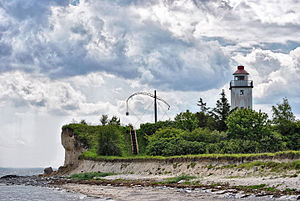Knudshoved Fyr
| Knudshoved Fyr | ||
|---|---|---|
| Knudshoved Fyr | ||
| Place: | Knudshoved Peninsula | |
| Location: | Syddanmark , Denmark | |
| Geographical location: | 55 ° 17 '24.9 " N , 10 ° 51' 4.9" E | |
| Fire carrier height : | 12 m | |
| Fire height : | 16 m | |
|
|
||
| Identifier : | Oc.WRG.10s | |
| Scope knows: | 12 nm (22.2 km ) | |
| Scope green: | 10 nm (18.5 km ) | |
| Scope red: | 10 nm (18.5 km ) | |
| Operating mode: | electric | |
| Function: | Sea fire | |
| Construction time: | 1727-1750 | |
| International ordinal number: | C1556 | |
Knudshoved Fyr is a lighthouse on the east side of the Danish Knudshoved peninsula , which lies southeast of Nyborg between Nyborg Fjord and the Great Belt .
history
The first fire sign was created by the post office between 1727 and 1750 and consisted of a rocker fire in which a basket with a coal fire was lifted up so that it could be seen from a distance.
In 1809 this construction was replaced by a three meter high tower with an argand lamp , which emitted a much stronger light. This lamp was invented by the Swiss physicist Aimé Argand in 1782 and had a tubular wick that the air could wipe both inside and outside.
The light was amplified by seven parabolic mirrors.
The next improvement came in 1822, as a lamp and mirror by a Siderallampe was replaced by Rear Admiral de Paul Løvenørn was developed since 1811 in the channel, port and Fire Directorate ( Danish channel, havne- og fyrdirektionen ) a Seat.
The lamp has a parabolic mirror that forms a parabola . This is rotated around its vertical axis through the focal point in which the light source is located. Løvenørn provided the description of the lamp to the Academy of Sciences. His far-sighted idea was that the lamp could rotate slowly so that it could produce a two-minute flash, which could lead to better bearing possibilities than the fast flashing lamps used at the time.
In 1857 the sidereal lamp was equipped with a lens device. In 1894 a seven-meter-high iron tower and a beacon system were built, which made an angle fire possible. From 1918 blue gas was used as an energy source.
The lighthouse that exists today was built in 1948. The rocking fire next to the lighthouse ( called "papegøjefyr" in Danish ), a fire barrel that can be lifted up with a movable mechanical arrangement, is a reconstruction that was built in 1983.
Individual evidence
- ↑ a b Explanation of terms. Retrieved March 21, 2017 (Danish).
- ↑ Det Kongelige Danske videnskabernes selskabs skrifter: Historisk og philosophisk afdeling . 1824, p. XVI ( limited preview in Google Book Search).
Web links
- Knudshoved Fyr. fyrtaarne.dk, accessed on March 21, 2017 (Danish).
- Om Knudshoved Fyr. The Danske store, accessed on March 21, 2017 (Danish).

